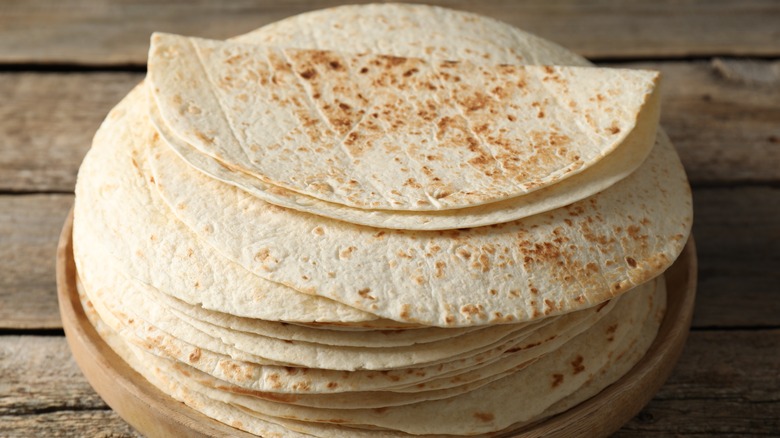This Is How You Achieve The Absolute Best Homemade Tortillas
Whether it's taco Tuesday or you're making enchiladas or fajitas, rather than sticking to the usual store-bought tortillas, why not try making them yourself? Homemade tortillas are not only more flavorful with a better texture; they're free of preservatives and other unnecessary additives, and aren't all that difficult to pull off, especially with some expert help. Chef Paula Muñoz, Executive Chef at Grand Hyatt Playa del Carmen, spoke with Today Meal and gave some exclusive insights into how to make homemade tortillas that beat store-bought any day.
According to Muñoz, one of the most important parts of homemade flour or corn tortillas is to start with high-quality flour. If you're opting for the flour, she advises that "You can also use a combination of all-purpose flour and a small amount of whole wheat flour for added flavor and texture." From there, she explains that mastering your kneading technique and paying attention to the dough's consistency can get you delicious and flavorful tortillas in a snap.
How to mix and knead tortilla dough
After choosing some quality flour, you'll need to incorporate water to turn it into a workable dough. Paula Muñoz says that you'll want warm water here: "This helps the dough come together more easily and results in a smoother texture." The warmth helps the gluten in the flour hydrate more quickly, which gives you a soft, stretchy texture for pliant, easy-to-press tortillas.
While adding fat is technically optional, Muñoz says it's a must-try tip for the best homemade tortillas. She suggests shortening, vegetable oil, or lard. All of these will help to make your dough even smoother, but each adds its own tasting notes to your tortillas. For instance, lard can impart a touch of the rich flavors of pork, while butter can add a milky, creamy, and slightly sweet hint to your dough. "You can adjust the amount of fat based on your preference for texture and flavor," Munoz adds, so you could start out conservatively and increase the fat in later batches.
Once the dough comes together, you're ready to knead it. Muñoz recommends kneading thoroughly to help ensure proper gluten development, as well as to distribute fat throughout for a consistent flavor. She adds, "This will help prevent cracking when you press out the tortillas." You could also knead in some fresh herbs at this step.
The shaping and cooking of tortillas
Once you're done kneading, Paula Muñoz explains that you don't want to dive right into shaping and cooking. Instead, let the dough rest for 30 minutes. "This allows the masa to fully hydrate and be easier to work with," she explains. She also notes that it helps the gluten relax, which will make it easier to roll out and shape.
Speaking of shaping, you can do this either by hand or using a tortilla press to create thin, well-shaped rounds. Don't own a press? Chef Muñoz says that having one isn't entirely necessary. Instead, "you can use a heavy skillet or flat pot to press the dough between two sheets of plastic or parchment paper."
Finally, cook the tortillas in a hot, dry pan. Muñoz says that they need "just a minute or two on each side until they start to puff up slightly and develop golden brown spots." You can flip the tortillas multiple times to ensure even browning all over. Just make sure to monitor them carefully, as it doesn't take much time for them to accidentally burn. If you're not ready to eat them right away (or you're feeding a crowd), Muñoz says you can keep them warm by placing them on a plate covered in a kitchen towel or foil. And if you wind up with leftovers, fire up the oven to make homemade chips.


